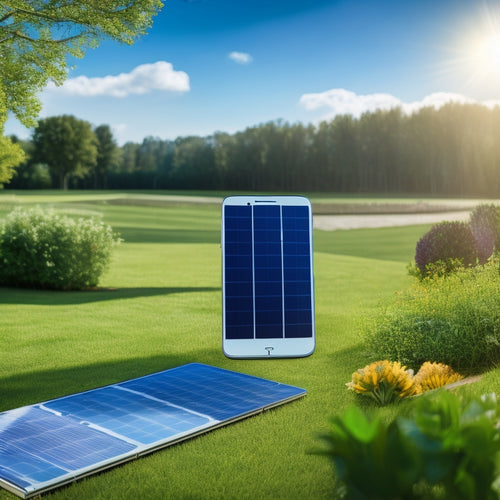10 Ways to Save With EV Charging Incentives
Share
You can reduce costs significantly by leveraging federal, state, and local incentives for EV charging infrastructure. Claim up to $1,000 in federal tax credits for EVSE installation, and explore additional state and local rebates. Utilities offer special discounts and tiered rates for EV owners, saving you up to 50% on charging costs. You can also optimize your charging habits to benefit from time-of-use pricing. Moreover, you can accelerate depreciation on EV charging equipment, reducing tax liability and boosting cash flow. By tapping into these incentives, you can maximize your savings and accelerate your return on investment - and there's more to discover.
Key Takeaways
• Claim up to $1,000 federal tax credit for EVSE installation, meeting specific safety and performance standards.
• Explore state and local incentives, including rebates, tax credits, or exemptions, to maximize savings on top of federal credits.
• Take advantage of utility company discounts and special rates, such as time-of-use pricing, to reduce EV charging bills by timing charging sessions strategically.
• Depreciate EV charging equipment quickly to reflect decreasing value over time, improving financial reporting accuracy and enhancing decision-making.
• Tap into site assessment grants and funding to offset costs, identify ideal charging locations, and assess energy demand for optimal infrastructure.
Federal Tax Credits for EVSE
When you install a qualified Electric Vehicle Supply Equipment (EVSE) at your home or business, you may be eligible for a federal tax credit of up to $1,000. This incentive is designed to encourage EV adoption and support the growth of the electric vehicle market.
To qualify, your EVSE must meet specific safety and performance standards. The credit is available for both residential and commercial installations, including home charging stations.
As part of the Tax Reform Act, this credit is a key federal policy driving EV adoption. By taking advantage of this credit, you can offset the cost of station installation and make EV ownership more affordable.
Review the credit eligibility criteria and claim your rebate to maximize your savings.
State and Local Incentives Available
You can also tap into state and local incentives that offer additional savings on top of federal credits. Many states and local governments offer rebates, tax credits, or exemptions to encourage EV adoption in their regions. These incentives can provide substantial savings, and it's crucial to explore what's available in your area.
You may be eligible for local rebates or government grants that can help offset the cost of EV charging equipment. For instance, some states offer rebates for EV charging stations, while others provide tax credits for EV owners. Be sure to research the specific incentives available in your state and locality to maximize your savings.
Utility Company Discounts Uncovered
Utility companies are now offering EV owners special discounts on their electricity rates, recognizing the unique energy demands of EVs and the potential for off-peak charging. You can benefit from these discounts by understanding your utility company's rate structures and billing cycles.
Many utilities offer tiered rate structures, where the cost of electricity decreases as your energy consumption increases. By charging your EV during off-peak hours, you can take advantage of lower rates and reduce your overall energy costs.
Be sure to review your utility company's rate structures and adjust your charging habits accordingly. By doing so, you can maximize your savings and minimize your environmental impact.
Special Rates for Off-Peak Charging
As you explore EV charging incentives, you'll find that many utilities offer special rates for off-peak charging, which can greatly reduce your energy costs.
Time-of-Use Pricing
What if you could slash your EV charging bills by timing your charging sessions strategically, taking advantage of lower rates offered by your utility during off-peak hours? With Time-of-Use (TOU) pricing, you can optimize your charging schedule to coincide with these discounted periods.
By adopting efficient scheduling, you can reduce your energy costs greatly. Many utilities offer smart rates that vary depending on the time of day and overall energy demand. By shifting your charging to off-peak hours, you can capitalize on lower rates and minimize your expenses.
Lower Overnight Rates
By charging your EV overnight, you can tap into lower rates offered by many utilities, which often slash their prices during these off-peak hours. This is because electricity demand is typically low at night, allowing utilities to reduce their rates. By taking advantage of these lower rates, you can save money on your EV charging costs.
Here are some benefits of charging your EV overnight:
-
Smart Scheduling: Charge your EV during off-peak hours when electricity rates are lowest, reducing your charging costs.
-
Energy Arbitrage: Take advantage of time-of-use pricing to buy energy at a low rate and sell it back to the grid at a higher rate.
-
Maximum Savings: Combine lower overnight rates with time-of-use pricing to maximize your savings and minimize your EV charging costs.
Time-of-Use Pricing Benefits
When you opt for time-of-use pricing, you'll benefit from lower peak hour rates and cheap off-peak charging. This means you'll pay less for electricity during off-peak hours, typically overnight, when you're charging your EV.
Lower Peak Hour Rates
With time-of-use pricing, your electric utility company charges you a lower rate for electricity consumed during off-peak hours, which can greatly reduce your EV charging costs. By taking advantage of these lower rates, you can optimize your charging schedule and minimize your expenses.
Here are some benefits of lower peak hour rates:
-
Save up to 50% on your EV charging costs by charging during off-peak hours
-
Gain control over your energy consumption and reduce your reliance on peak hour electricity
-
Maximize your savings with Rate Optimization Strategies and Peak Hour Analysis, ensuring you're getting the best possible deal on your EV charging costs
Cheap Off-Peak Charging
You can greatly reduce your EV charging costs by taking advantage of cheap off-peak charging rates, which can be up to 50% lower than peak hour rates. By shifting your charging schedule to off-peak hours, you can capitalize on Time-of-Use (TOU) pricing benefits.
Smart Scheduling allows you to automate this process, ensuring your EV is fully charged when you need it, while taking advantage of the cheapest energy rates.
Additionally, Energy Harvesting technologies can further optimize your charging routine, allowing you to store excess energy generated during off-peak hours for later use. By leveraging these strategies, you can maximize your savings and minimize your environmental footprint.
Demand Response Programs Explained
Demand response programs, designed to manage energy distribution during peak usage hours, offer EV owners a lucrative opportunity to monetize their charging flexibility. By participating in these programs, you can earn revenue by adjusting your charging habits in response to grid demands.
This can be achieved through:
-
Peak Shaving: reducing your energy consumption during peak hours to alleviate stress on the grid
-
Load Shifting: shifting your charging to off-peak hours when energy demand is low
-
Optimizing Your Charging Schedule: adjusting your charging schedule to align with the grid's energy availability
Net Metering for Commercial Properties
Commercial properties can greatly reduce their energy costs by leveraging net metering, a policy that allows them to generate their own electricity and export any excess back to the grid.
By installing on-site EV charging stations or renewable energy systems, you can offset your energy consumption and reduce your reliance on the grid.
This approach enables you to manage your energy usage more effectively, practicing peak shaving and load management strategies to minimize your energy expenditure.
With net metering, you can even sell excess energy back to the grid, generating revenue and further reducing your costs.
EV Charging Depreciation Benefits
As you invest in EV charging infrastructure, you're likely wondering how to maximize your returns. Fortunately, the IRS offers a helping hand through accelerated depreciation benefits, allowing you to recoup your investment faster.
Accelerated Depreciation Benefits
You can greatly reduce your tax liability by leveraging accelerated depreciation benefits for your EV charging infrastructure, which allows you to write off a substantial portion of the costs in the first few years of ownership. This strategy enables you to create a significant tax shield, reducing your taxable income and increasing your cash flow.
By depreciating your EV charging assets quickly, you can:
-
Maximize your tax savings: Accelerated depreciation benefits allow you to claim a larger tax deduction in the early years of ownership.
-
Optimize asset valuation: By depreciating your assets quickly, you can accurately reflect their decreasing value over time.
-
Improve your bottom line: By reducing your tax liability, you can increase your profitability and reinvest your savings in your business.
Bonus Depreciation Savings
In addition to accelerated depreciation, you can claim up to 100% bonus depreciation on qualified EV charging equipment, greatly reducing your taxable income in the first year of ownership. This bonus depreciation allows you to deduct the full cost of the equipment in the first year, providing significant tax savings. By combining accelerated depreciation and bonus depreciation, you can maximize your tax savings and accelerate your return on investment.
| Depreciation Strategy | Savings Analysis |
|---|---|
| Accelerated Depreciation | Reduces taxable income by 30% in the first year |
| Bonus Depreciation | Reduces taxable income by an additional 70% in the first year |
| Combined Depreciation | Reduces taxable income by up to 100% in the first year |
| 5-Year MACRS | Provides additional tax savings over 5 years |
| Custom Depreciation | Allows for tailored depreciation strategies for unique situations |
Site Assessment Grants and Funding
Electric vehicle (EV) charging station developers can tap into site assessment grants and funding opportunities to offset the costs associated with evaluating potential charging locations. You can leverage these incentives to identify ideal sites, assess energy demand, and optimize your charging infrastructure. By taking advantage of these grants and funding strategies, you can reduce your upfront costs and accelerate your project timeline.
Some notable opportunities include:
-
The US Department of Transportation's Alternative Fuel Corridor grants, which provide funding for EV charging infrastructure along highways
-
The US Department of Energy's Loan Guarantee Program, which offers financing for large-scale EV charging projects
-
State-specific grants and funding programs, which vary by region but can provide critical support for local EV charging initiatives
EV-Ready Infrastructure Incentives
Building codes and zoning regulations can now be future-proofed with EV-ready infrastructure incentives, which encourage developers to incorporate charging infrastructure into new construction and renovation projects. This forward-thinking approach supports Green Building initiatives and the development of Smart Cities. By incorporating EV charging infrastructure, you can increase your property's value and appeal to environmentally conscious tenants.
| Incentive Type | Description | Benefits |
|---|---|---|
| Tax Credits | Reduce tax liability for EV-ready infrastructure | Increased ROI |
| Zoning Variances | Expedited permitting and approval process | Faster project timelines |
| Density Bonuses | Increased building density allowances | Higher property values |
| Low-Interest Loans | Financing options for EV-ready infrastructure | Reduced upfront costs |
| Green Building Certifications | Recognition for sustainable development | Enhanced marketability |
Frequently Asked Questions
Are EV Charging Incentives Available for Residential or Commercial Use Only?
You'll find EV charging incentives available for both residential and commercial use, with some programs targeting public access or rural development projects, offering benefits for infrastructure development and expanded charging networks.
Can I Claim Multiple Incentives for the Same EV Charging Station?
As you're fueling your EV, you wonder if you can double-dip on incentives. Yes, you can claim multiple incentives for the same station, but be aware of claim limits to avoid incentive stacking restrictions.
Do EV Charging Incentives Vary by Type of Electric Vehicle?
You'll find that EV charging incentives do vary by type of electric vehicle, with distinctions made based on vehicle classification, such as passenger or commercial, and EV range, which can impact the amount of incentives you're eligible for.
Are EV Charging Incentives Taxable as Income?
When filing your taxes, you'll be relieved to know that EV charging incentives are generally not considered taxable income, so they won't impact your income bracket or complicate your tax filing process.
Can I Transfer EV Charging Incentives to a New Owner?
As you hand over the keys to your prized EV, you wonder if you can transfer the coveted charging incentives to the new owner, granting the Seller Benefits and Incentive Portability, but the answer is not a simple yes or no.
Related Posts
-

3 Best Eco-Grants for Home Energy Upgrades
You're eligible for various eco-grants that can help you cut down on energy bills and reduce your carbon footprint by...
-

Why EVs Inspire Earth-Conscious Home Design Choices
As you shift to an electric vehicle, you're not just switching to a greener ride, you're igniting a broader commitmen...
-

7 Best Solar Panel Upkeep Apps for Homeowners
You can optimize your solar panel's energy output and efficiency by up to 20% with regular maintenance, which is wher...


